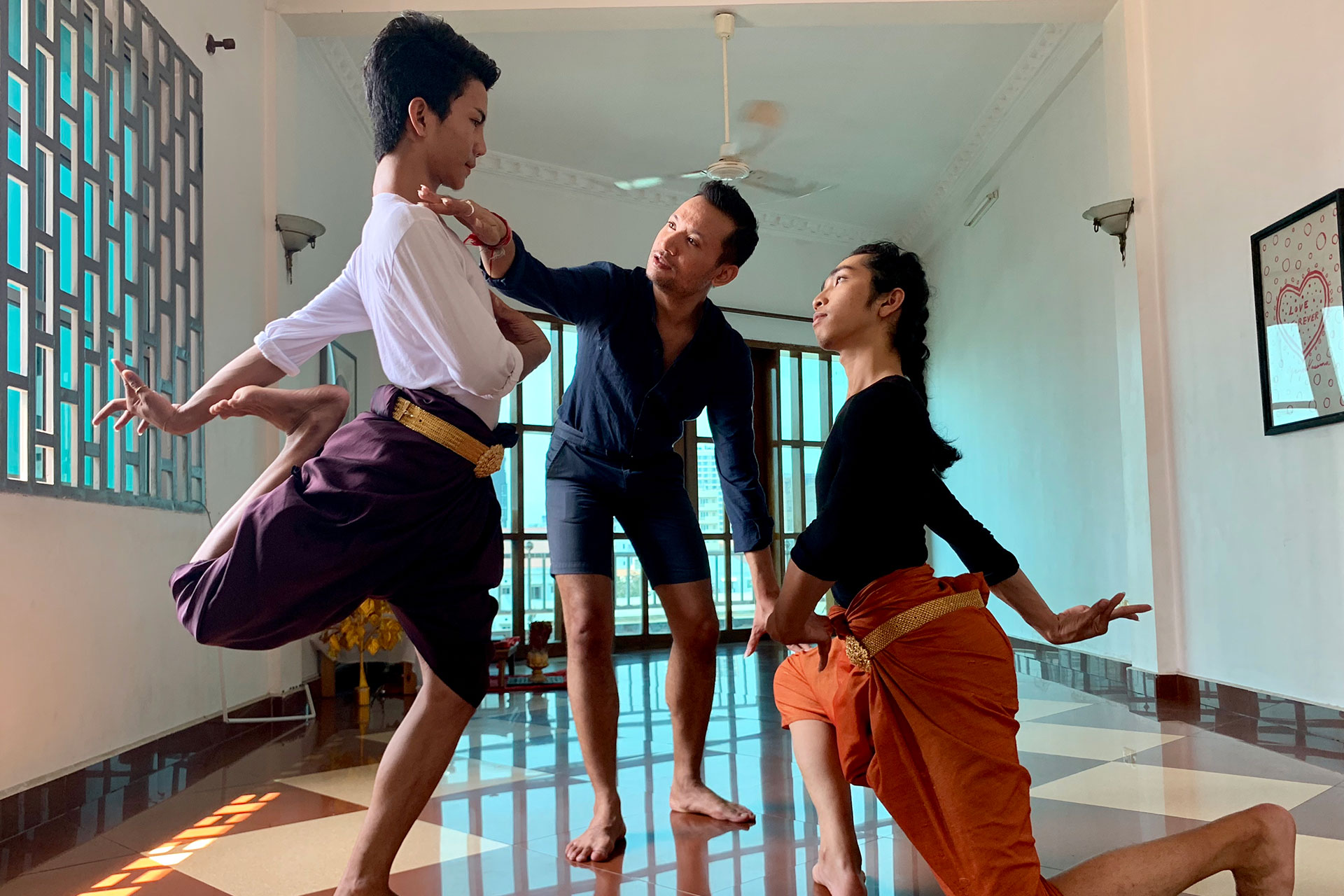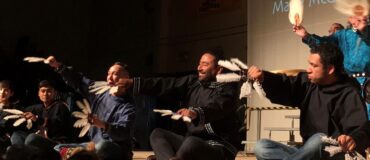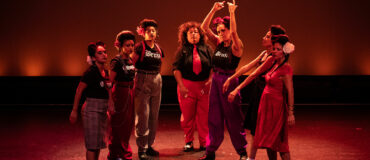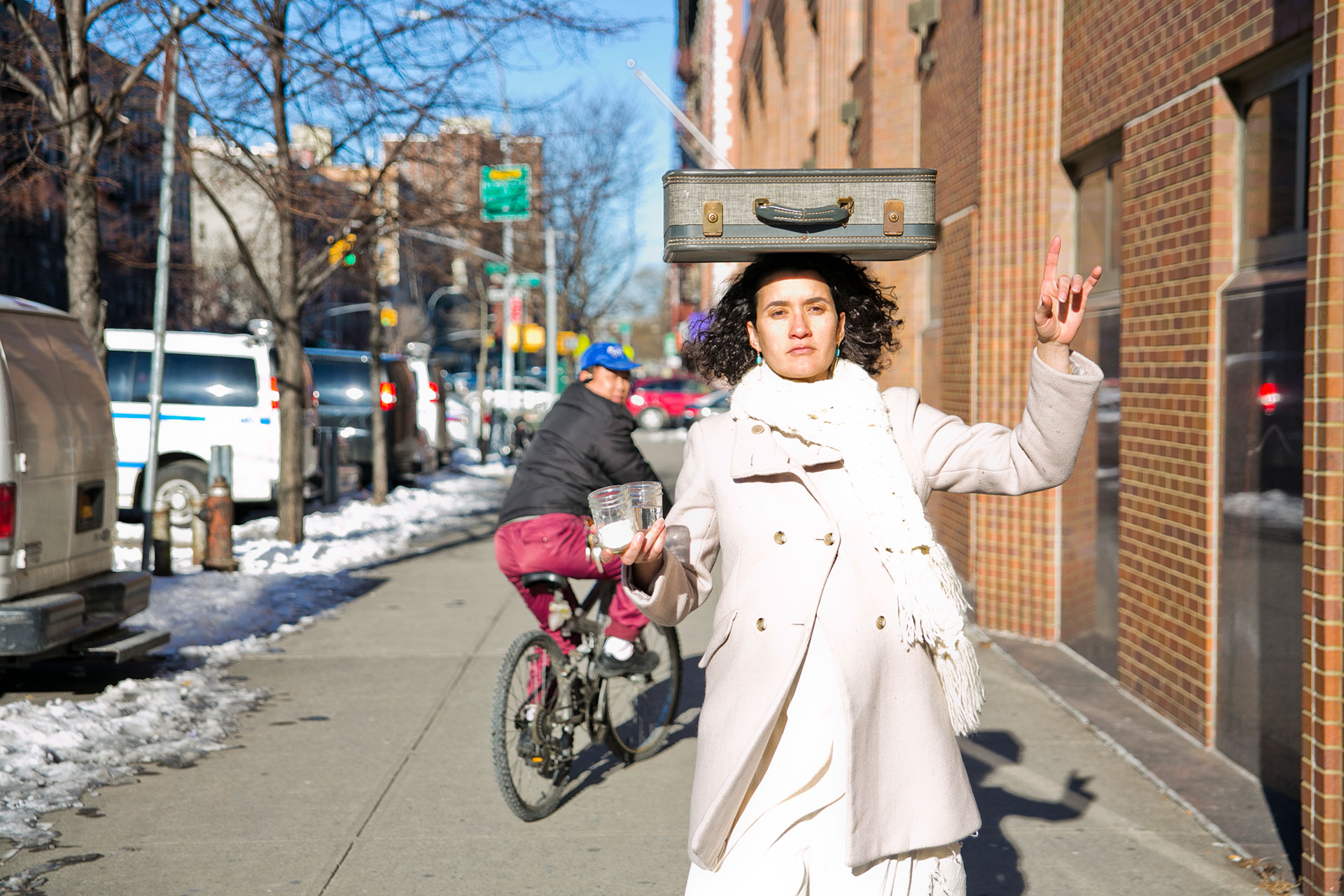Compartiendo Historias
Yvonne Montoya and José Navarrete
By J. Soto
Editor’s note:This article is one of 11 in a series examining the creative work of 31 dance artists funded by Dance/USA Fellowship to Artists, generously supported by the Doris Duke Charitable Foundation. These artists’ practices are embedded in social change as they work in multiple dance forms in communities across the country.

José Navarrete’s collaborative Y Basta Ya! (Enough!) is a work-in-progress using personal stories from members of Mujeres Unidas y Activas (MUA), a Bay Area community organization for Latina immigrants. The work shares stories of domestic violence, sexual abuse, and immigration. Photo: Scott Tsuchitani
In Tucson during monsoon season, the scorching heat is regularly broken by thunderous rainstorms every afternoon, but for the past week it has been dry and unbearably hot. On this Wednesday afternoon, Yvonne Montoya, and her son, Buddy, who is 12 years old, are at home preparing to share the next installment of Stories From Home: COVID-19 Addendum, a web-series she developed in response to the dramatic changes the global pandemic has caused in the performing arts industry.
On the same afternoon, more than 800 miles away, members of Bay Area-based collective Mujeres Unidas Activas (MUA) begin an online meeting with members of No Te Rindas, a collective of women from Mexico City. The two groups will share their stories and art-healing practices with performers José Navarrete and Debby Kajiyama, who co-direct NAKA Dance Theater in San Francisco. Navarrete works regularly with MUA, a grassroots organization of Latina immigrant women that promotes personal transformation and builds community power for social and economic justice. Together they are developing a piece called Y Basta Ya! (Enough!).

Yvonne Montoya’s “Homeschool” is part of her three-month online Stories From Home: COVID-19 Addendum, which includes her son, Buddy, and shares the universal challenges of parenting and homeschooling, along with the added complexity of being a working artist. Photo: Dominic AZ Bonuccelli
Dance/USA Artist Fellows Montoya and Navarrete are Latinx dancers who use participatory research and collaboration with their respective communities in the U.S./Mexico Southwest and the Bay Area to bring visibility to Latinx performers and empower these communities by fostering social change. In realizing their projects, each choreographer works for years to develop the trust and confianza that are necessary for participants to fully share their stories, which are performed by the community members they work with, guiding the artistic direction of each piece.
Though both artists work with their local Latinx communities, each project is informed by different needs and experiences of the respective community involved. Montoya, originally from New Mexico, wears many hats: as a mother, choreographer, and the founder of Safos Dance Theatre. Navarrete, born in Mexico City, is a dancer, teacher, and community organizer, who engages in local partnerships to provide mutual aid and create performances. Each is informed by their Latinx identity. Rather than center citizenship or nationality, Montoya’s and Navarrete’s practices offer a deep understanding of dance making across and beyond borders — national and local — while acknowledging the impacts of immigration and narratives of belonging and empowerment.
CROSS-BORDER COLLABORATIONS
As a Latinx woman committed to working with Latinx dancers in cross-border collaborations locally and internationally at a time when the current U.S. administration perpetrates legislative violence toward Brown and Black communities, Montoya’s work sheds light on the challenges the border represents as a symbol of xenophobia, and on opportunities for cross-border community building. Deeply committed to more representation of Latinx dancers onstage and as teachers, Montoya works to connect dancers at multiple levels of development to peers in the field. Her artistic practice tells multi-generational stories of Latinx people in the Southwest United States. Through regular in-person pre-COVID rehearsals with dancers throughout Arizona, New Mexico, and Sonora, Mexico, and also through her studio-based professional development initiative, Dance in the Desert, she has been collaboratively building a sense of local community.

Montoya, mother, dancemaker, bi-national artist, and founder of Safos Dance Theatre in Tucson, Ariz., grounds her artistic practice in the landscapes, languages, cultures, and aesthetics of the U.S. Southwest. Here Ruby Morales performs Stories From Home, a series based on Montoya’s family oral histories. Photo: Yvonne Montoya
For her piece, Stories From Home: COVID-19 Addendum, Montoya worked remotely with dancers from Tucson and Phoenix, Ariz., and, Albuquerque, N.M., among other cities. Addendum was a series of eleven mini-performances, split into two acts, which ran from mid-July through mid-September 2020, on Instagram Live. The first act featured Montoya and Buddy drawing on mundane and difficult experiences while at home during the pandemic as she “responds to the joys and challenges of parenthood while maintaining a performing arts career, and the sudden new responsibility of being a home-school educator.” The original Stories From Home, developed for the stage, has not premiered in its entirety. The piece was due to premier at the Kennedy Center in Washington, D.C., in September of 2020, but was postponed due to the pandemic. The second act in Addendum featured the choreography and stories from the original on-stage cast.
The original Stories From Home was inspired by oral histories collected from her family members, including her great-grandmother, grandmother, father, and great-aunts. Montoya says the piece highlights “Southwest oral traditions and explores the intersections of Latinx identities, histories, languages, cultures, and regionalisms in the Southwest.” She plans to premiere the work on stage for a live audience in 2021.
The distances in the Addendum web-series feel palpable. The screen mediates nearly every interaction through a mobile phone or a video camera. During Remote Piano Lessons, the movements inside the home impart the exhaustion of the moment combined with the urgency to adapt everything online. The camera movements are sharp and the choreographed movements sometimes frantic or humorous. In Walking, the low-slung roofs of the older Tucson neighborhood offer a familiar inter-generational backdrop for those who have spent time or lived there.
Navarrete became connected to MUA in 2014 following an invitation from staff member Aide Rodriguez to teach movement-healing classes to the immigrant women. Two years later, he and Kajiyama began a new work, Y Basta Ya! They met weekly with the women to hear about their immigration and work experiences and listen to their stories. Navarrete acknowledges the privilege of working with the women of MUA as an outside community member, and the importance of building trust and mutual care. The outcome of the work, including if and how their personal testimonies are presented, remains in the hands of the women.

Navarrete’s RACE: Stories from the Tenderloin explores the violent impact that massive sporting events, technology, and gentrification have on poor city residents. It was performed by a group of residents of SRO hotels in San Francisco’s Tenderloin neighborhood. Photo: Scott Tsuchitani
His collaborative process for Y Basta Ya! was inspired by After Life, the 1998 Japanese film edited, written, and directed by Hirokazu Koreeda. The film is based on the question, “What is it in your life you would like to keep for eternity?” It is striking for its generosity, care, and resourcefulness in recreating the memories for each person lost. In creating the performance, Navarrete draws on this question to develop and share testimony with the women of MUA. Together they uncover personal reflections in the studio. Recently, Julita, a 62-year-old performer from Guatemala, began sharing her experiences as a seamstress in her hometown after working with ribbons, which had been incorporated into the process. For Navarrete, and the women of MUA, the work on Y Basta Ya! demands a commitment to build intergenerational relationships in the group.
BRIDGING GEOGRAPHICAL DISTANCE
Both Montoya and Navarrete have shifted their practices to respond to the danger brought on by physical distancing and the COVID-19 pandemic. MUA members have been meeting online weekly and text messaging regularly. In addition to the danger of the virus and loss of jobs, many people in immigrant Latinx communities continue to fear deportation, which continues despite the publicized increased risk of virus transmission in ICE detention facilities. The threat of deportation has impacted Montoya’s family. One of the dances in COVID-19 Addendum conveys the ritual of writing postcards to her brother-in-law, who contracted COVID-19 while detained in an ICE detention facility in Eloy, Ariz.; while his family awaited his release.
In these moments of deep uncertainty and change, the shift to creating online has also allowed for connections between these artists and geographically distant communities. MUA members from San Francisco and Oakland now connect virtually with members in Union City, Calif., 30 miles away, to share experiences. Physical distancing and meeting online have brought parts of the Bay Area Latina immigrant community together through socially engaged practice. Many have family in Mexico City and continue to build alliances with groups similar in purpose, such as No Te Rindas (“Don’t Give Up”), which supports women whose family members have disappeared, as they work through trauma and grief together.

A México City native, Navarrete asserts that his work stands in the intersection of experimental art and activism. He uses art as a frame for social justice and facilitates practices that work in depth with local communities, allowing collaborators to learn through the artistic practice. Photo: Steven Sanchez
Yet, adequate access to technology remains a challenge. The MUA collective is intergenerational and most members connect to the meetings on their smartphones using data, instead of through Wi-Fi at home. As the performing arts field connects online more frequently, not everyone is able to have access from home or in the same way. Some in these communities are not digital natives, particularly older people, or they may be experiencing domestic violence, or cannot afford, or have no access to Wi-Fi. In 2019, Pew Research Center noted that 61 percent of Hispanic adults had broadband service at home, compared to 79 percent of their white counterparts, and that reliance on smartphones for connection was especially common among younger adults, non-whites, and lower-income Americans.* Finding ways to connect individuals and groups online and addressing gaps in access to technology are important to these projects, as well as to the field as a whole.
In a year that dramatically shifted our concepts of home, care, and artistry, artists like Montoya and Navarrete are turning toward what is closest to them: documenting the intimacy of the moment and necessity of support and care. Their intentionally paced trajectories highlight deep trust-building in social practice performance, and the value of local and regional funding so artists can create practices that allow community members who are most impacted to lead the way.
*Pew Research Center, “Internet/Broadband Fact Sheet”: https://www.pewresearch.org/internet/fact-sheet/internet-broadband/
.jpg)
J. Soto is an arts administrator and consultant invested in the intersectional community histories and present of queer people of color and disabled people. Soto’s work focuses on how to create more equitable practices and access to resources in the arts and dance field. His writing can be found in Original Plumbing, Apogee Journal: Queer History, Queer Now Folio, American Realness 2018 Reading series, and Jacob’s Pillow Dance Interactive (forthcoming) and Grant Makers in the Arts, GIA Reader (forthcoming). His work is deeply influenced by his experiences as a queer transgender Latino who grew up in the Bay Area, with roots in Southern Arizona and the borderlands. He lives and works in Queens, N.Y.
Please visit the artists’ websites: Yvonne Montoya and José Navarrete. Readers may read and print a PDF version of this article here. Readers may visit and share this article on Medium here. A Spanish translation of this article may be found here. Find more information on the DFA Article Series here and more information on Dance/USA Fellowships to artists here.
____
We accept submissions on topics relevant to the field: advocacy, artistic issues, arts policy, community building, development, employment, engagement, touring, and other topics that deal with the business of dance. We cannot publish criticism, single-company season announcements, and single-company or single artist profiles. Additionally, we welcome feedback on articles. If you have a topic that you would like to see addressed or feedback, please contact communications@danceusa.org.
Disclaimer: Opinions expressed in guest posts do not necessarily represent the viewpoints of Dance/USA.





